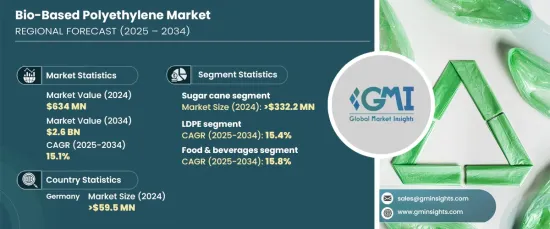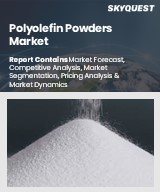
|
시장보고서
상품코드
1666967
바이오 기반 폴리에틸렌 시장 기회, 성장 촉진요인, 산업 동향 분석, 예측(2025-2034년)Bio-based Polyethylene Market Opportunity, Growth Drivers, Industry Trend Analysis, and Forecast 2025 - 2034 |
||||||
바이오 기반 폴리에틸렌 세계 시장은 2024년에 6억 3,400만 달러로 평가되며 2025년부터 2034년까지 연평균 15.1%로 성장할 것으로 예상됩니다.
이 시장은 산업계가 지속가능한 솔루션과 환경적 책임에 대한 중요성을 강조함에 따라 괄목할 만한 성장세를 보이고 있습니다. 바이오 PE는 사탕수수와 같은 재생 가능한 원료로 생산되며, 화석연료를 원료로 하는 기존의 폴리에틸렌을 대체할 수 있는 친환경적인 대안을 제시합니다. 탄소 배출량을 줄이고 친환경적인 관행을 채택하라는 기업의 압력이 증가함에 따라 이러한 전환은 더욱 가속화되고 있습니다.

시장 확대의 주요 요인 중 하나는 바이오 PE 생산에 사탕수수와 같은 재생 가능한 자원을 사용하는 방향으로의 전환입니다. 사탕수수는 고효율의 재생 가능한 원료로, 발효 과정에서 필요한 당분을 공급하여 에탄올을 만들고 이를 폴리에틸렌으로 전환하는 데 필요한 당분을 공급합니다. 사탕수수는 특히 열대 기후 지역에서 널리 재배되기 때문에 비용 효율적이고 쉽게 구할 수 있는 자원입니다. 또한, 사탕수수를 사용하면 이산화탄소 배출량을 줄이고 화석연료에 대한 의존도를 낮출 수 있기 때문에 바이오 기반 폴리에틸렌 시장에서 사탕수수의 매력은 더욱 커지고 있습니다.
| 시장 범위 | |
|---|---|
| 시작 연도 | 2024년 |
| 예측 연도 | 2025-2034년 |
| 시작 금액 | 6억 3,400만 달러 |
| 예상 금액 | 26억 달러 |
| CAGR | 15.1% |
다양한 원료 중 사탕수수를 원료로 하는 분야가 가장 우세하며 시장 점유율의 대부분을 차지하고 있습니다. 이 분야는 사탕수수의 효율성과 재생 가능성으로 인해 지속가능한 소재에 대한 수요 증가와 맞물려 견고한 성장 궤도를 유지할 것으로 예상됩니다.
제품 유형별로는 저밀도 폴리에틸렌(LDPE)이 가장 큰 시장 점유율을 차지하고 있으며, 유연성, 내습성, 가공 용이성으로 인해 연포장, 농업용 필름, 각종 소비재 등의 용도에 적합하다는 평가를 받고 있습니다. 지속가능한 포장 솔루션에 대한 수요로 인해 바이오 기반 LDPE의 채택이 증가하고 있으며, 특히 사탕수수나 옥수수와 같은 재생 가능한 재료로부터 공급될 수 있기 때문에 더욱 각광받고 있습니다.
독일의 바이오 기반 폴리에틸렌 시장은 강력한 산업 인프라, 지속가능한 관행에 대한 노력, 광범위한 연구 개발 노력으로 인해 2024년에 큰 수익을 창출했습니다. 녹색 화학 및 제조 기술의 발전은 바이오 기반 플라스틱 생산에서 경쟁력을 유지하는 데 도움이 되어 이 시장 부문의 성장을 주도하고 있습니다.
목차
제1장 조사 방법과 조사 범위
- 시장 범위와 정의
- 기본 추정과 계산
- 예측 계산
- 데이터 소스
- 1차 데이터
- 2차 데이터
- 유료 정보 출처
- 공적 정보 출처
제2장 주요 요약
제3장 업계 인사이트
- 생태계 분석
- 밸류체인에 영향을 미치는 요인
- 이익률 분석
- 파괴
- 향후 전망
- 제조업체
- 유통업체
- 공급업체 상황
- 이익률 분석
- 주요 뉴스와 대처
- 규제 상황
- 영향요인
- 성장 촉진요인
- 지속가능한 포장에 대한 수요 증가
- 친환경 제품에 대한 소비자 기호 상승
- 재생 소재를 추진하는 정부 규제
- 업계의 잠재적 리스크와 과제
- 기존 폴리에틸렌에 비해 높은 제조 비용
- 성장 촉진요인
- 성장 가능성 분석
- Porters 분석
- PESTEL 분석
제4장 경쟁 구도
- 소개
- 기업 점유율 분석
- 경쟁 포지셔닝 매트릭스
- 전략 전망 매트릭스
제5장 시장 추정과 예측 : 원료별, 2021-2034년
- 주요 동향
- 사탕수수
- 사탕무우
- 기타
제6장 시장 추정과 예측 : 제품별, 2021-2034년
- 주요 동향
- HDPE
- LDPE
- LLDPE
제7장 시장 추정과 예측 : 최종 용도별, 2021-2034년
- 주요 동향
- 식품 및 음료
- 농업
- 의약품
- 화장품·퍼스널케어
- 섬유
- 기타
제8장 시장 추정과 예측 : 지역별, 2021-2034년
- 주요 동향
- 북미
- 미국
- 캐나다
- 유럽
- 영국
- 독일
- 프랑스
- 이탈리아
- 스페인
- 러시아
- 아시아태평양
- 중국
- 인도
- 일본
- 한국
- 호주
- 라틴아메리카
- 브라질
- 멕시코
- 중동 및 아프리카
- 남아프리카공화국
- 사우디아라비아
- 아랍에미리트
제9장 기업 개요
- Avery Dennison
- BASF
- BRASKEM
- FKuR
- Kuraray
- LyondellBasell
- Mitsui Chemicals
- SABIC
- The Dow Chemical Company
- Toyota Tsusho Corporation
The Global Bio-Based Polyethylene Market was valued at USD 634 million in 2024 and is projected to grow at a CAGR of 15.1% during 2025-2034. This market has seen remarkable growth as industries increasingly focus on sustainable solutions and environmental responsibility. Bio-PE is produced from renewable raw materials, such as sugarcane, offering an eco-friendly alternative to conventional polyethylene, which is derived from fossil fuels. This transition is gaining momentum as companies face growing pressure to reduce carbon emissions and adopt greener practices.

One of the key drivers of market expansion is the shift toward using renewable sources like sugarcane for bio-PE production. Sugarcane is a highly efficient and renewable feedstock that provides the necessary sugars for fermentation processes to create ethanol, which is then converted into polyethylene. The widespread cultivation of sugarcane, particularly in tropical climates, makes it a cost-effective and readily available resource. Additionally, using sugarcane helps lower carbon emissions and reduces reliance on fossil fuels, further boosting its appeal in the bio-based polyethylene market.
| Market Scope | |
|---|---|
| Start Year | 2024 |
| Forecast Year | 2025-2034 |
| Start Value | $634 Million |
| Forecast Value | $2.6 Billion |
| CAGR | 15.1% |
Among the various feedstocks, the sugarcane-based segment is the most dominant, accounting for a significant portion of the market share. This segment is expected to maintain a robust growth trajectory, driven by sugarcane's efficiency and renewability, which aligns with the growing demand for sustainable materials.
The market is also segmented by product type, with Low-Density Polyethylene (LDPE) holding the largest share. LDPE is favored for its flexibility, moisture resistance, and ease of processing, making it ideal for applications such as flexible packaging, agricultural films, and various consumer products. The demand for sustainable packaging solutions has led to increased adoption of bio-based LDPE, particularly due to its potential for being sourced from renewable materials like sugarcane and corn.
Germany bio-based polyethylene market generated significant revenue in 2024 owing to its strong industrial infrastructure, a commitment to sustainable practices, and extensive research and development efforts. The country's advancements in green chemistry and manufacturing technologies have helped it maintain a competitive edge in bio-based plastic production, driving growth in this market segment.
Table of Contents
Chapter 1 Methodology & Scope
- 1.1 Market scope & definitions
- 1.2 Base estimates & calculations
- 1.3 Forecast calculations
- 1.4 Data sources
- 1.4.1 Primary
- 1.4.2 Secondary
- 1.4.2.1 Paid sources
- 1.4.2.2 Public sources
Chapter 2 Executive Summary
- 2.1 Industry synopsis, 2021-2034
Chapter 3 Industry Insights
- 3.1 Industry ecosystem analysis
- 3.1.1 Factor affecting the value chain
- 3.1.2 Profit margin analysis
- 3.1.3 Disruptions
- 3.1.4 Future outlook
- 3.1.5 Manufacturers
- 3.1.6 Distributors
- 3.2 Supplier landscape
- 3.3 Profit margin analysis
- 3.4 Key news & initiatives
- 3.5 Regulatory landscape
- 3.6 Impact forces
- 3.6.1 Growth drivers
- 3.6.1.1 Increasing demand for sustainable packaging
- 3.6.1.2 Rising consumer preference for eco-friendly products
- 3.6.1.3 Government regulations promoting renewable materials
- 3.6.2 Industry pitfalls & challenges
- 3.6.2.1 High production costs compared to conventional polyethylene
- 3.6.1 Growth drivers
- 3.7 Growth potential analysis
- 3.8 Porter’s analysis
- 3.9 PESTEL analysis
Chapter 4 Competitive Landscape, 2024
- 4.1 Introduction
- 4.2 Company market share analysis
- 4.3 Competitive positioning matrix
- 4.4 Strategic outlook matrix
Chapter 5 Market Estimates & Forecast, By Raw material, 2021-2034 (USD Million) (Kilo Tons)
- 5.1 Key trends
- 5.2 Sugar cane
- 5.3 Sugar beet
- 5.4 Others
Chapter 6 Market Estimates & Forecast, By Product, 2021-2034 (USD Million) (Kilo Tons)
- 6.1 Key trends
- 6.2 HDPE
- 6.3 LDPE
- 6.4 LLDPE
Chapter 7 Market Estimates & Forecast, By End Use, 2021-2034 (USD Million) (Kilo Tons)
- 7.1 Key trends
- 7.2 Food & beverages
- 7.3 Agriculture
- 7.4 Pharmaceutical
- 7.5 Cosmetics & personal care
- 7.6 Textile
- 7.7 Others
Chapter 8 Market Estimates & Forecast, By Region, 2021-2034 (USD Million) (Kilo Tons)
- 8.1 Key trends
- 8.2 North America
- 8.2.1 U.S.
- 8.2.2 Canada
- 8.3 Europe
- 8.3.1 UK
- 8.3.2 Germany
- 8.3.3 France
- 8.3.4 Italy
- 8.3.5 Spain
- 8.3.6 Russia
- 8.4 Asia Pacific
- 8.4.1 China
- 8.4.2 India
- 8.4.3 Japan
- 8.4.4 South Korea
- 8.4.5 Australia
- 8.5 Latin America
- 8.5.1 Brazil
- 8.5.2 Mexico
- 8.6 MEA
- 8.6.1 South Africa
- 8.6.2 Saudi Arabia
- 8.6.3 UAE
Chapter 9 Company Profiles
- 9.1 Avery Dennison
- 9.2 BASF
- 9.3 BRASKEM
- 9.4 FKuR
- 9.5 Kuraray
- 9.6 LyondellBasell
- 9.7 Mitsui Chemicals
- 9.8 SABIC
- 9.9 The Dow Chemical Company
- 9.10 Toyota Tsusho Corporation



















